Relationship Between Roach's Cs of Caring and NMBA Code of Conduct
VerifiedAdded on 2023/01/13
|8
|1839
|89
Report
AI Summary
This report examines Sister Simone Roach's 6 C's of caring, focusing on competence, confidence, and compassion, and their relationship with the NMBA Code of Conduct. The report details how these attributes contribute to safe, high-quality nursing care, aligning with the NMBA's ethical and legal expectations. Competence is discussed in terms of technical skills, patient assessment, and knowledge application, including adherence to codes 1.2 and 2.2. Confidence is presented as crucial for fostering trust and managing end-of-life care, referencing codes 3.4 and 3.6, and maintaining professional boundaries as per code 4.1. Compassion is highlighted as essential for patient well-being and effective communication, with reference to code 3.3 and 7.1. The report emphasizes the importance of these three C's in enhancing patient satisfaction and promoting ethical nursing practice.
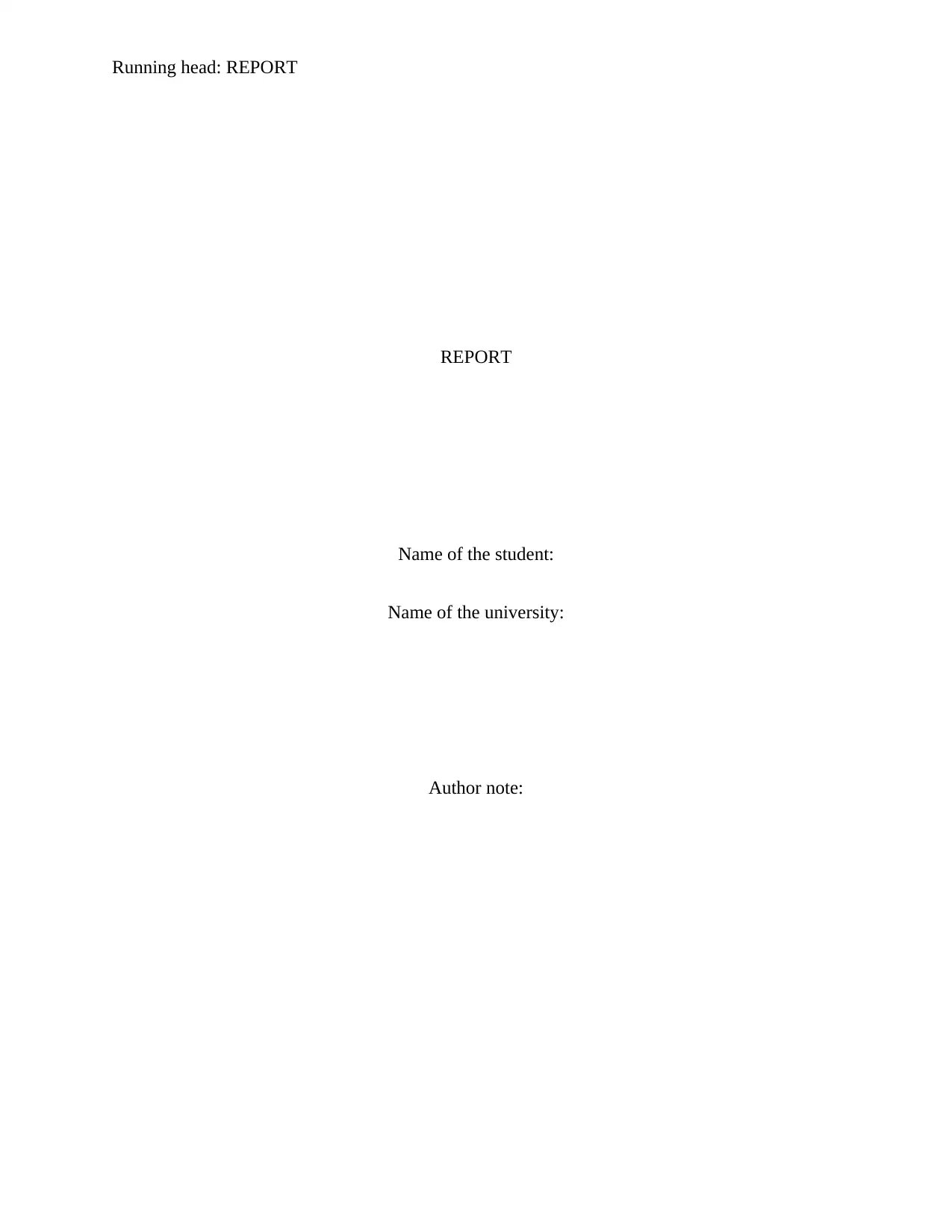
Running head: REPORT
REPORT
Name of the student:
Name of the university:
Author note:
REPORT
Name of the student:
Name of the university:
Author note:
Paraphrase This Document
Need a fresh take? Get an instant paraphrase of this document with our AI Paraphraser
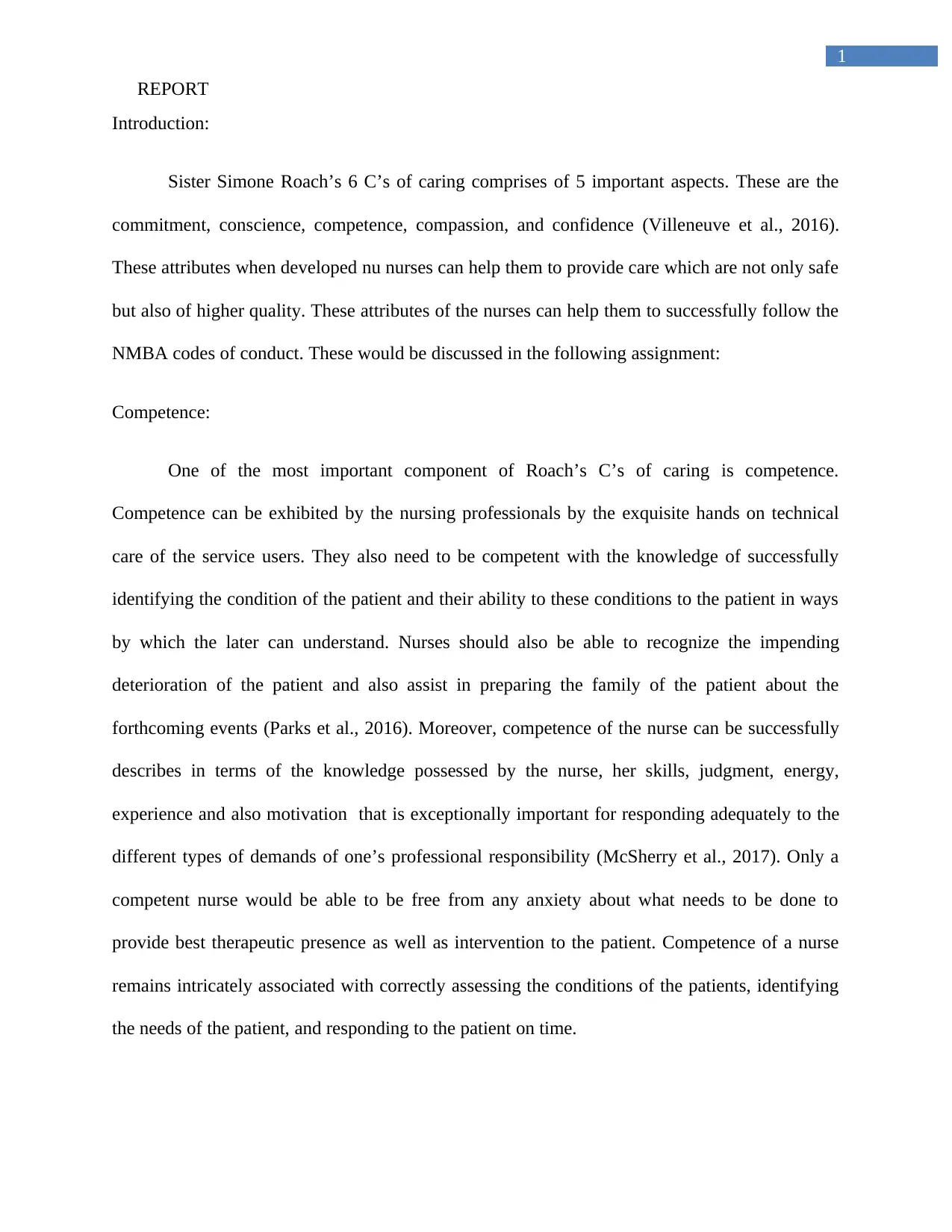
1
REPORT
Introduction:
Sister Simone Roach’s 6 C’s of caring comprises of 5 important aspects. These are the
commitment, conscience, competence, compassion, and confidence (Villeneuve et al., 2016).
These attributes when developed nu nurses can help them to provide care which are not only safe
but also of higher quality. These attributes of the nurses can help them to successfully follow the
NMBA codes of conduct. These would be discussed in the following assignment:
Competence:
One of the most important component of Roach’s C’s of caring is competence.
Competence can be exhibited by the nursing professionals by the exquisite hands on technical
care of the service users. They also need to be competent with the knowledge of successfully
identifying the condition of the patient and their ability to these conditions to the patient in ways
by which the later can understand. Nurses should also be able to recognize the impending
deterioration of the patient and also assist in preparing the family of the patient about the
forthcoming events (Parks et al., 2016). Moreover, competence of the nurse can be successfully
describes in terms of the knowledge possessed by the nurse, her skills, judgment, energy,
experience and also motivation that is exceptionally important for responding adequately to the
different types of demands of one’s professional responsibility (McSherry et al., 2017). Only a
competent nurse would be able to be free from any anxiety about what needs to be done to
provide best therapeutic presence as well as intervention to the patient. Competence of a nurse
remains intricately associated with correctly assessing the conditions of the patients, identifying
the needs of the patient, and responding to the patient on time.
REPORT
Introduction:
Sister Simone Roach’s 6 C’s of caring comprises of 5 important aspects. These are the
commitment, conscience, competence, compassion, and confidence (Villeneuve et al., 2016).
These attributes when developed nu nurses can help them to provide care which are not only safe
but also of higher quality. These attributes of the nurses can help them to successfully follow the
NMBA codes of conduct. These would be discussed in the following assignment:
Competence:
One of the most important component of Roach’s C’s of caring is competence.
Competence can be exhibited by the nursing professionals by the exquisite hands on technical
care of the service users. They also need to be competent with the knowledge of successfully
identifying the condition of the patient and their ability to these conditions to the patient in ways
by which the later can understand. Nurses should also be able to recognize the impending
deterioration of the patient and also assist in preparing the family of the patient about the
forthcoming events (Parks et al., 2016). Moreover, competence of the nurse can be successfully
describes in terms of the knowledge possessed by the nurse, her skills, judgment, energy,
experience and also motivation that is exceptionally important for responding adequately to the
different types of demands of one’s professional responsibility (McSherry et al., 2017). Only a
competent nurse would be able to be free from any anxiety about what needs to be done to
provide best therapeutic presence as well as intervention to the patient. Competence of a nurse
remains intricately associated with correctly assessing the conditions of the patients, identifying
the needs of the patient, and responding to the patient on time.
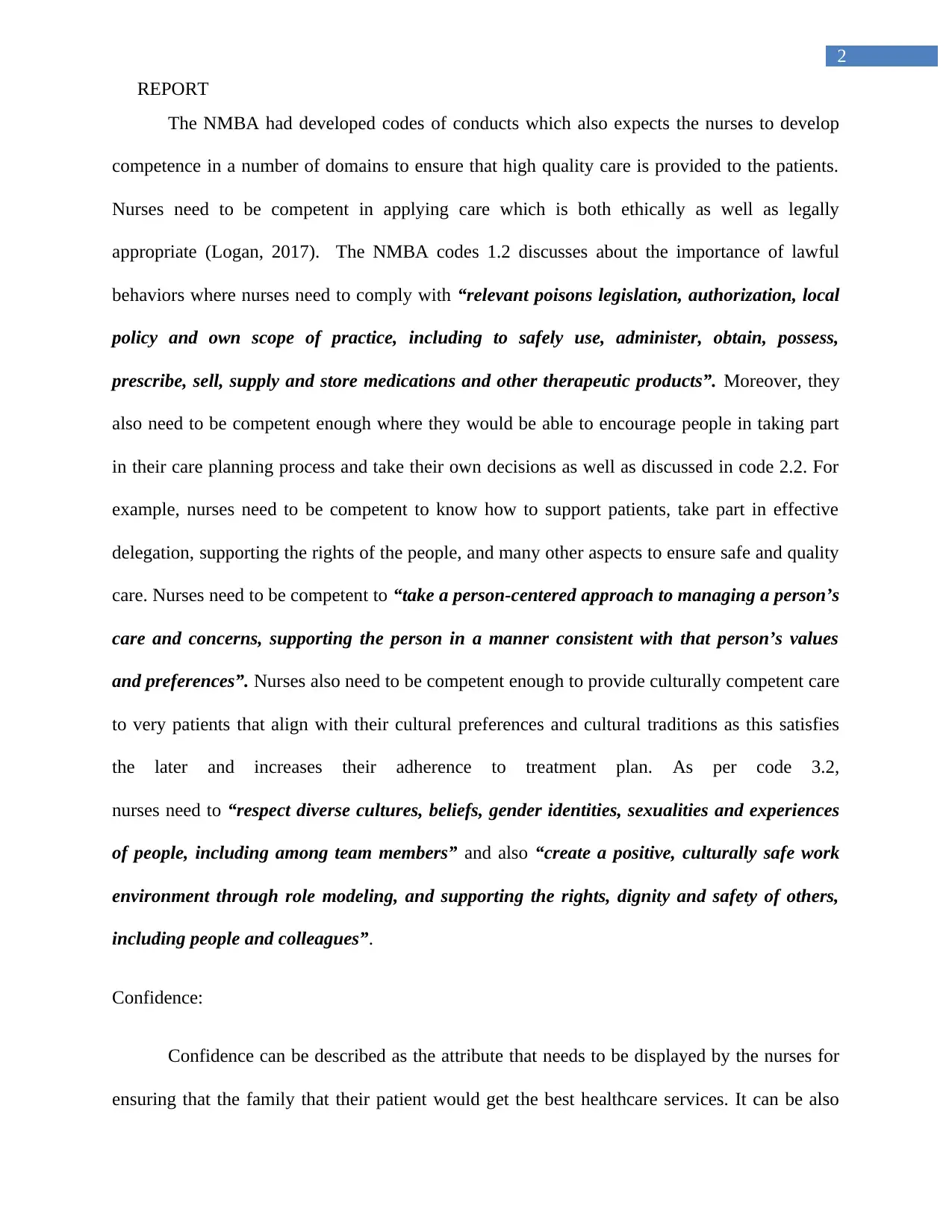
2
REPORT
The NMBA had developed codes of conducts which also expects the nurses to develop
competence in a number of domains to ensure that high quality care is provided to the patients.
Nurses need to be competent in applying care which is both ethically as well as legally
appropriate (Logan, 2017). The NMBA codes 1.2 discusses about the importance of lawful
behaviors where nurses need to comply with “relevant poisons legislation, authorization, local
policy and own scope of practice, including to safely use, administer, obtain, possess,
prescribe, sell, supply and store medications and other therapeutic products”. Moreover, they
also need to be competent enough where they would be able to encourage people in taking part
in their care planning process and take their own decisions as well as discussed in code 2.2. For
example, nurses need to be competent to know how to support patients, take part in effective
delegation, supporting the rights of the people, and many other aspects to ensure safe and quality
care. Nurses need to be competent to “take a person-centered approach to managing a person’s
care and concerns, supporting the person in a manner consistent with that person’s values
and preferences”. Nurses also need to be competent enough to provide culturally competent care
to very patients that align with their cultural preferences and cultural traditions as this satisfies
the later and increases their adherence to treatment plan. As per code 3.2,
nurses need to “respect diverse cultures, beliefs, gender identities, sexualities and experiences
of people, including among team members” and also “create a positive, culturally safe work
environment through role modeling, and supporting the rights, dignity and safety of others,
including people and colleagues”.
Confidence:
Confidence can be described as the attribute that needs to be displayed by the nurses for
ensuring that the family that their patient would get the best healthcare services. It can be also
REPORT
The NMBA had developed codes of conducts which also expects the nurses to develop
competence in a number of domains to ensure that high quality care is provided to the patients.
Nurses need to be competent in applying care which is both ethically as well as legally
appropriate (Logan, 2017). The NMBA codes 1.2 discusses about the importance of lawful
behaviors where nurses need to comply with “relevant poisons legislation, authorization, local
policy and own scope of practice, including to safely use, administer, obtain, possess,
prescribe, sell, supply and store medications and other therapeutic products”. Moreover, they
also need to be competent enough where they would be able to encourage people in taking part
in their care planning process and take their own decisions as well as discussed in code 2.2. For
example, nurses need to be competent to know how to support patients, take part in effective
delegation, supporting the rights of the people, and many other aspects to ensure safe and quality
care. Nurses need to be competent to “take a person-centered approach to managing a person’s
care and concerns, supporting the person in a manner consistent with that person’s values
and preferences”. Nurses also need to be competent enough to provide culturally competent care
to very patients that align with their cultural preferences and cultural traditions as this satisfies
the later and increases their adherence to treatment plan. As per code 3.2,
nurses need to “respect diverse cultures, beliefs, gender identities, sexualities and experiences
of people, including among team members” and also “create a positive, culturally safe work
environment through role modeling, and supporting the rights, dignity and safety of others,
including people and colleagues”.
Confidence:
Confidence can be described as the attribute that needs to be displayed by the nurses for
ensuring that the family that their patient would get the best healthcare services. It can be also
⊘ This is a preview!⊘
Do you want full access?
Subscribe today to unlock all pages.

Trusted by 1+ million students worldwide
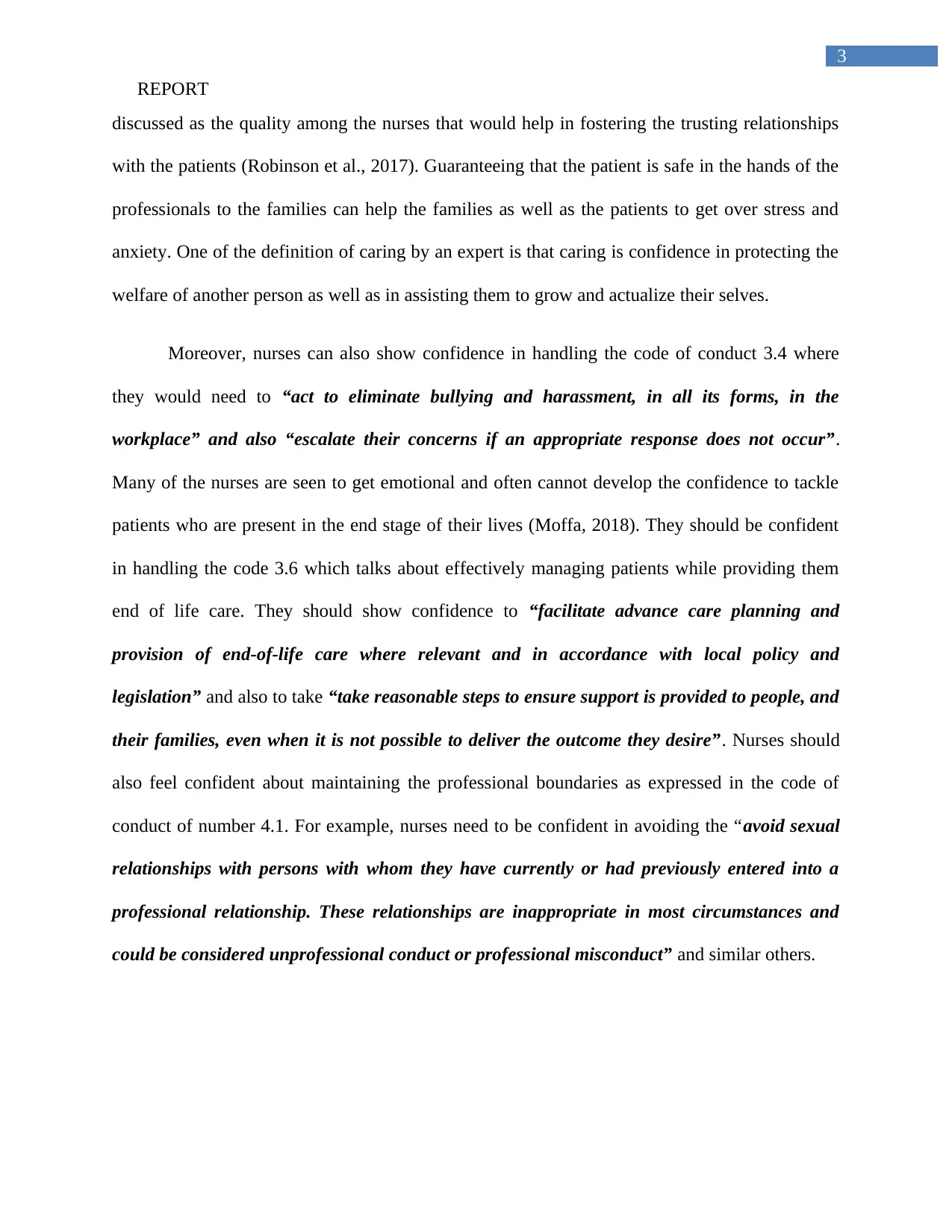
3
REPORT
discussed as the quality among the nurses that would help in fostering the trusting relationships
with the patients (Robinson et al., 2017). Guaranteeing that the patient is safe in the hands of the
professionals to the families can help the families as well as the patients to get over stress and
anxiety. One of the definition of caring by an expert is that caring is confidence in protecting the
welfare of another person as well as in assisting them to grow and actualize their selves.
Moreover, nurses can also show confidence in handling the code of conduct 3.4 where
they would need to “act to eliminate bullying and harassment, in all its forms, in the
workplace” and also “escalate their concerns if an appropriate response does not occur”.
Many of the nurses are seen to get emotional and often cannot develop the confidence to tackle
patients who are present in the end stage of their lives (Moffa, 2018). They should be confident
in handling the code 3.6 which talks about effectively managing patients while providing them
end of life care. They should show confidence to “facilitate advance care planning and
provision of end-of-life care where relevant and in accordance with local policy and
legislation” and also to take “take reasonable steps to ensure support is provided to people, and
their families, even when it is not possible to deliver the outcome they desire”. Nurses should
also feel confident about maintaining the professional boundaries as expressed in the code of
conduct of number 4.1. For example, nurses need to be confident in avoiding the “avoid sexual
relationships with persons with whom they have currently or had previously entered into a
professional relationship. These relationships are inappropriate in most circumstances and
could be considered unprofessional conduct or professional misconduct” and similar others.
REPORT
discussed as the quality among the nurses that would help in fostering the trusting relationships
with the patients (Robinson et al., 2017). Guaranteeing that the patient is safe in the hands of the
professionals to the families can help the families as well as the patients to get over stress and
anxiety. One of the definition of caring by an expert is that caring is confidence in protecting the
welfare of another person as well as in assisting them to grow and actualize their selves.
Moreover, nurses can also show confidence in handling the code of conduct 3.4 where
they would need to “act to eliminate bullying and harassment, in all its forms, in the
workplace” and also “escalate their concerns if an appropriate response does not occur”.
Many of the nurses are seen to get emotional and often cannot develop the confidence to tackle
patients who are present in the end stage of their lives (Moffa, 2018). They should be confident
in handling the code 3.6 which talks about effectively managing patients while providing them
end of life care. They should show confidence to “facilitate advance care planning and
provision of end-of-life care where relevant and in accordance with local policy and
legislation” and also to take “take reasonable steps to ensure support is provided to people, and
their families, even when it is not possible to deliver the outcome they desire”. Nurses should
also feel confident about maintaining the professional boundaries as expressed in the code of
conduct of number 4.1. For example, nurses need to be confident in avoiding the “avoid sexual
relationships with persons with whom they have currently or had previously entered into a
professional relationship. These relationships are inappropriate in most circumstances and
could be considered unprofessional conduct or professional misconduct” and similar others.
Paraphrase This Document
Need a fresh take? Get an instant paraphrase of this document with our AI Paraphraser
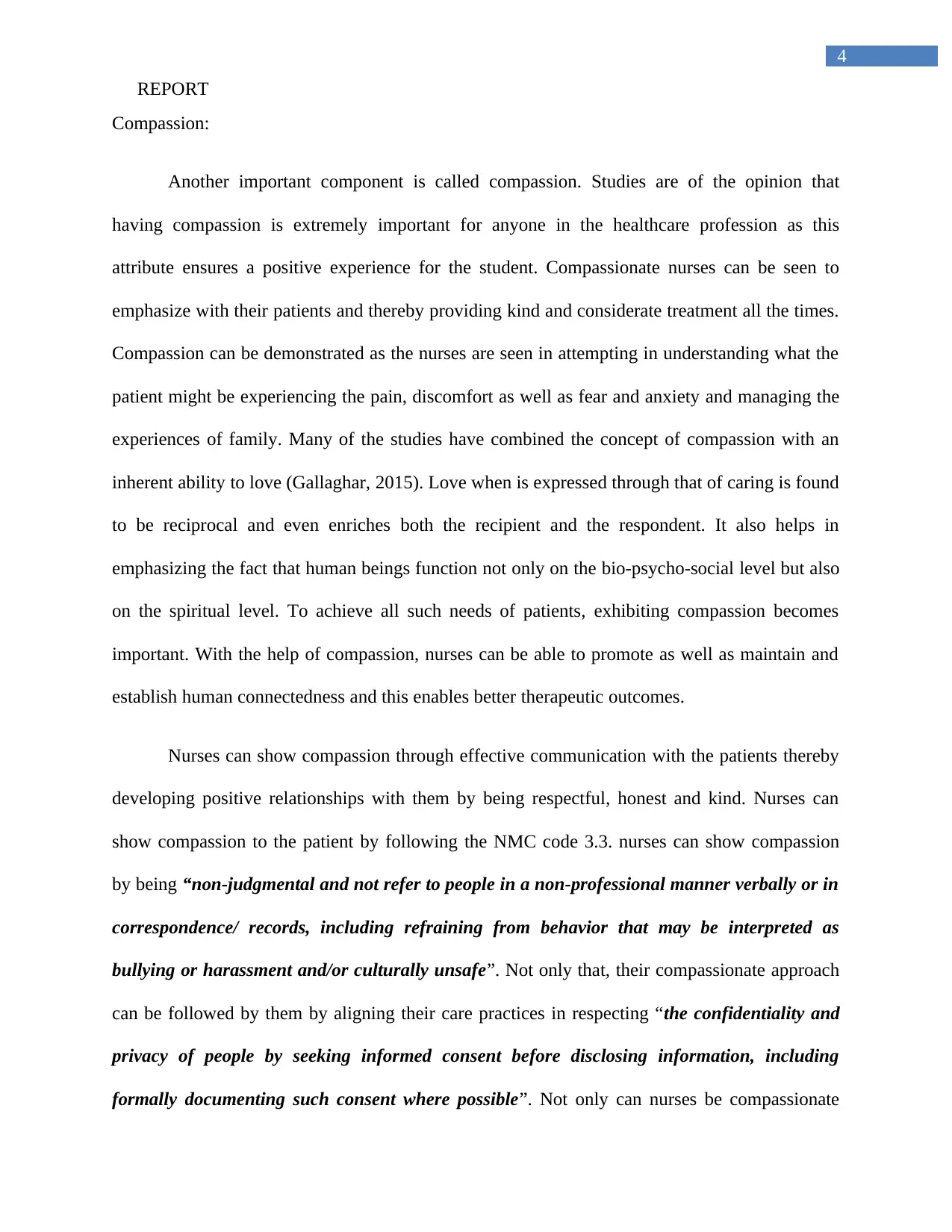
4
REPORT
Compassion:
Another important component is called compassion. Studies are of the opinion that
having compassion is extremely important for anyone in the healthcare profession as this
attribute ensures a positive experience for the student. Compassionate nurses can be seen to
emphasize with their patients and thereby providing kind and considerate treatment all the times.
Compassion can be demonstrated as the nurses are seen in attempting in understanding what the
patient might be experiencing the pain, discomfort as well as fear and anxiety and managing the
experiences of family. Many of the studies have combined the concept of compassion with an
inherent ability to love (Gallaghar, 2015). Love when is expressed through that of caring is found
to be reciprocal and even enriches both the recipient and the respondent. It also helps in
emphasizing the fact that human beings function not only on the bio-psycho-social level but also
on the spiritual level. To achieve all such needs of patients, exhibiting compassion becomes
important. With the help of compassion, nurses can be able to promote as well as maintain and
establish human connectedness and this enables better therapeutic outcomes.
Nurses can show compassion through effective communication with the patients thereby
developing positive relationships with them by being respectful, honest and kind. Nurses can
show compassion to the patient by following the NMC code 3.3. nurses can show compassion
by being “non-judgmental and not refer to people in a non-professional manner verbally or in
correspondence/ records, including refraining from behavior that may be interpreted as
bullying or harassment and/or culturally unsafe”. Not only that, their compassionate approach
can be followed by them by aligning their care practices in respecting “the confidentiality and
privacy of people by seeking informed consent before disclosing information, including
formally documenting such consent where possible”. Not only can nurses be compassionate
REPORT
Compassion:
Another important component is called compassion. Studies are of the opinion that
having compassion is extremely important for anyone in the healthcare profession as this
attribute ensures a positive experience for the student. Compassionate nurses can be seen to
emphasize with their patients and thereby providing kind and considerate treatment all the times.
Compassion can be demonstrated as the nurses are seen in attempting in understanding what the
patient might be experiencing the pain, discomfort as well as fear and anxiety and managing the
experiences of family. Many of the studies have combined the concept of compassion with an
inherent ability to love (Gallaghar, 2015). Love when is expressed through that of caring is found
to be reciprocal and even enriches both the recipient and the respondent. It also helps in
emphasizing the fact that human beings function not only on the bio-psycho-social level but also
on the spiritual level. To achieve all such needs of patients, exhibiting compassion becomes
important. With the help of compassion, nurses can be able to promote as well as maintain and
establish human connectedness and this enables better therapeutic outcomes.
Nurses can show compassion through effective communication with the patients thereby
developing positive relationships with them by being respectful, honest and kind. Nurses can
show compassion to the patient by following the NMC code 3.3. nurses can show compassion
by being “non-judgmental and not refer to people in a non-professional manner verbally or in
correspondence/ records, including refraining from behavior that may be interpreted as
bullying or harassment and/or culturally unsafe”. Not only that, their compassionate approach
can be followed by them by aligning their care practices in respecting “the confidentiality and
privacy of people by seeking informed consent before disclosing information, including
formally documenting such consent where possible”. Not only can nurses be compassionate
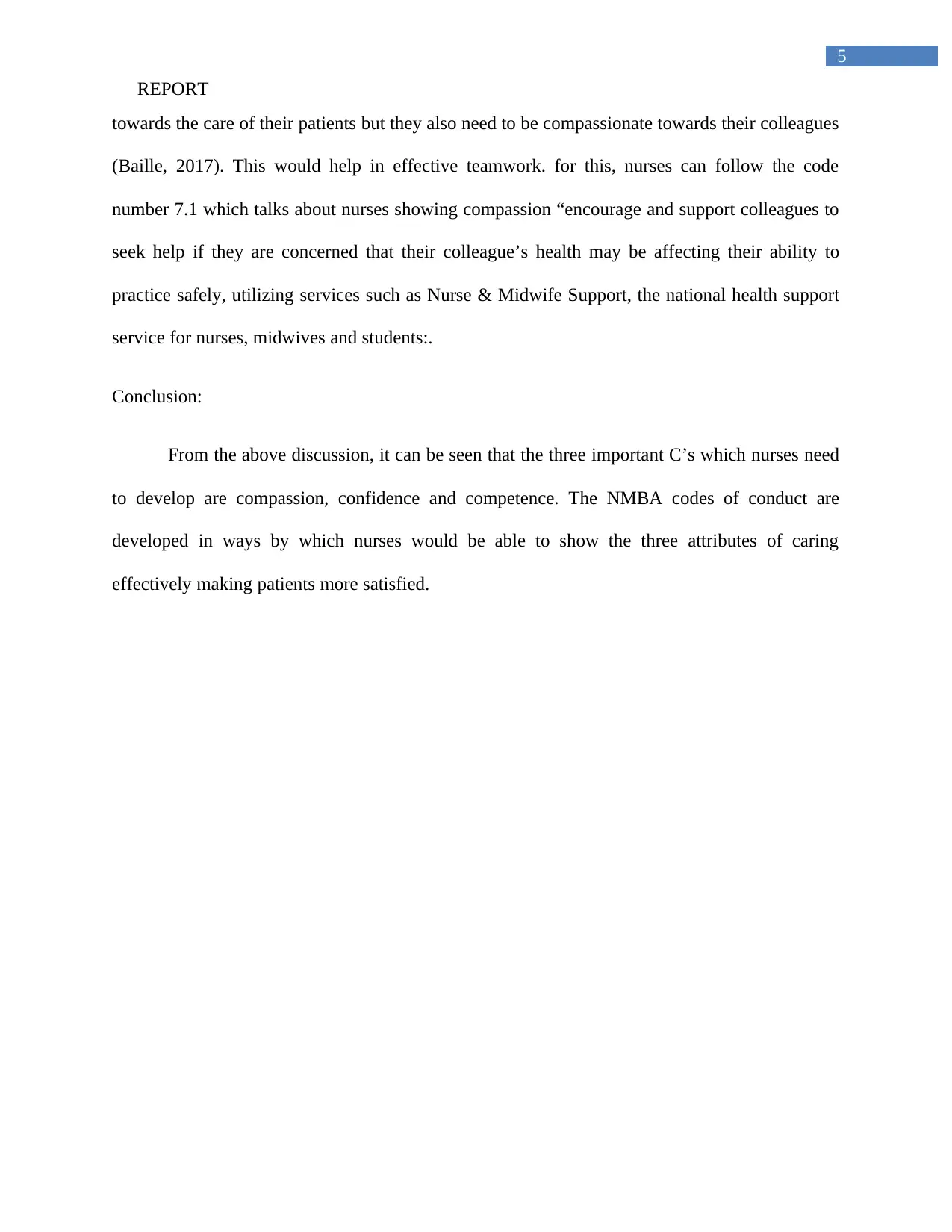
5
REPORT
towards the care of their patients but they also need to be compassionate towards their colleagues
(Baille, 2017). This would help in effective teamwork. for this, nurses can follow the code
number 7.1 which talks about nurses showing compassion “encourage and support colleagues to
seek help if they are concerned that their colleague’s health may be affecting their ability to
practice safely, utilizing services such as Nurse & Midwife Support, the national health support
service for nurses, midwives and students:.
Conclusion:
From the above discussion, it can be seen that the three important C’s which nurses need
to develop are compassion, confidence and competence. The NMBA codes of conduct are
developed in ways by which nurses would be able to show the three attributes of caring
effectively making patients more satisfied.
REPORT
towards the care of their patients but they also need to be compassionate towards their colleagues
(Baille, 2017). This would help in effective teamwork. for this, nurses can follow the code
number 7.1 which talks about nurses showing compassion “encourage and support colleagues to
seek help if they are concerned that their colleague’s health may be affecting their ability to
practice safely, utilizing services such as Nurse & Midwife Support, the national health support
service for nurses, midwives and students:.
Conclusion:
From the above discussion, it can be seen that the three important C’s which nurses need
to develop are compassion, confidence and competence. The NMBA codes of conduct are
developed in ways by which nurses would be able to show the three attributes of caring
effectively making patients more satisfied.
⊘ This is a preview!⊘
Do you want full access?
Subscribe today to unlock all pages.

Trusted by 1+ million students worldwide
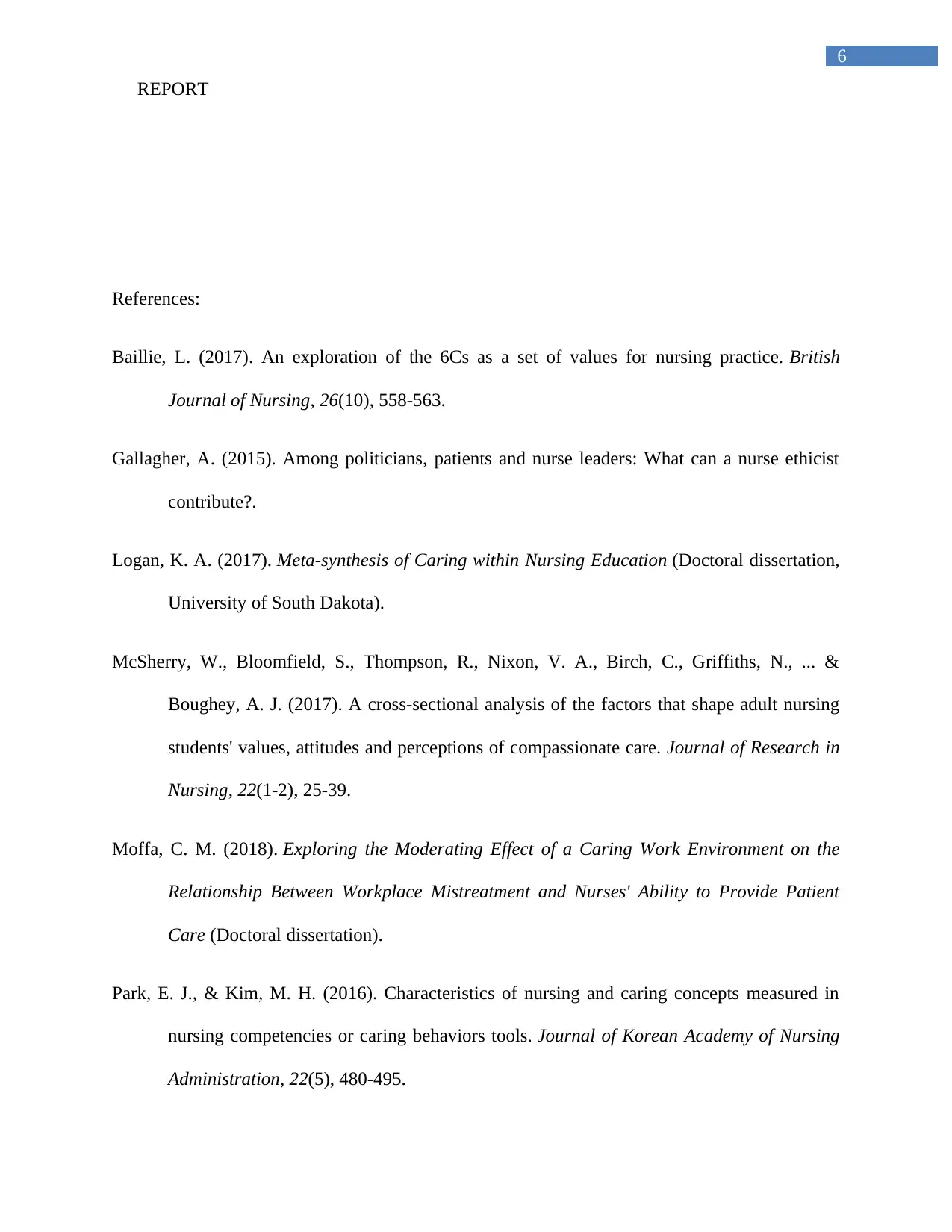
6
REPORT
References:
Baillie, L. (2017). An exploration of the 6Cs as a set of values for nursing practice. British
Journal of Nursing, 26(10), 558-563.
Gallagher, A. (2015). Among politicians, patients and nurse leaders: What can a nurse ethicist
contribute?.
Logan, K. A. (2017). Meta-synthesis of Caring within Nursing Education (Doctoral dissertation,
University of South Dakota).
McSherry, W., Bloomfield, S., Thompson, R., Nixon, V. A., Birch, C., Griffiths, N., ... &
Boughey, A. J. (2017). A cross-sectional analysis of the factors that shape adult nursing
students' values, attitudes and perceptions of compassionate care. Journal of Research in
Nursing, 22(1-2), 25-39.
Moffa, C. M. (2018). Exploring the Moderating Effect of a Caring Work Environment on the
Relationship Between Workplace Mistreatment and Nurses' Ability to Provide Patient
Care (Doctoral dissertation).
Park, E. J., & Kim, M. H. (2016). Characteristics of nursing and caring concepts measured in
nursing competencies or caring behaviors tools. Journal of Korean Academy of Nursing
Administration, 22(5), 480-495.
REPORT
References:
Baillie, L. (2017). An exploration of the 6Cs as a set of values for nursing practice. British
Journal of Nursing, 26(10), 558-563.
Gallagher, A. (2015). Among politicians, patients and nurse leaders: What can a nurse ethicist
contribute?.
Logan, K. A. (2017). Meta-synthesis of Caring within Nursing Education (Doctoral dissertation,
University of South Dakota).
McSherry, W., Bloomfield, S., Thompson, R., Nixon, V. A., Birch, C., Griffiths, N., ... &
Boughey, A. J. (2017). A cross-sectional analysis of the factors that shape adult nursing
students' values, attitudes and perceptions of compassionate care. Journal of Research in
Nursing, 22(1-2), 25-39.
Moffa, C. M. (2018). Exploring the Moderating Effect of a Caring Work Environment on the
Relationship Between Workplace Mistreatment and Nurses' Ability to Provide Patient
Care (Doctoral dissertation).
Park, E. J., & Kim, M. H. (2016). Characteristics of nursing and caring concepts measured in
nursing competencies or caring behaviors tools. Journal of Korean Academy of Nursing
Administration, 22(5), 480-495.
Paraphrase This Document
Need a fresh take? Get an instant paraphrase of this document with our AI Paraphraser

7
REPORT
Robinson Wolf, Z., & France, N. E. (2017). Caring in Nursing Theory. International Journal for
Human Caring, 21(2).
Villeneuve, M. J., Tschudin, V., Storch, J., Fowler, M. D., & Peter, E. (2016). A very human
being: Sister Marie Simone Roach, 1922–2016. Nursing inquiry, 23(4), 283-289.
REPORT
Robinson Wolf, Z., & France, N. E. (2017). Caring in Nursing Theory. International Journal for
Human Caring, 21(2).
Villeneuve, M. J., Tschudin, V., Storch, J., Fowler, M. D., & Peter, E. (2016). A very human
being: Sister Marie Simone Roach, 1922–2016. Nursing inquiry, 23(4), 283-289.
1 out of 8
Related Documents
Your All-in-One AI-Powered Toolkit for Academic Success.
+13062052269
info@desklib.com
Available 24*7 on WhatsApp / Email
![[object Object]](/_next/static/media/star-bottom.7253800d.svg)
Unlock your academic potential
Copyright © 2020–2025 A2Z Services. All Rights Reserved. Developed and managed by ZUCOL.





